

Editor: Jaap Horst
 |
| Labric and Veyron's T57G "Tank" at the start of the 1937 24 hour race. |
 |
| The Type 13, driven by Friderich |
The Le Mans circuit has been very important to Bugatti, ever from July 23, 1911, when his little "Type 13" driven by Bugatti's mechanic Ernest Friderich, was to finish second after a large Fiat driven by Hemery, after all the other cars had dropped out. At this stage Le Mans was not a 24 hours race, the race in question being the French Grand Prix, held on a circuit different from the later 24 hours one.
Later, from 1928 to 1930, Bugatti organised a special, purely Bugatti race for his clients, the "Grands Prix Bugatti". These of course were open only to Bugattis, and were held on the Le Mans circuit. Obviously he liked the circuit, but why did it last him so long (until 1931) to enter officially in the 24 hour race??
Probable answer for this has to be sought in what Le Mans really was in the beginning. Of course it was a good idea, but, not so much of a true race as well as a kind of public test for constructors and their clients. Ettore might want to enter his mythical Type 35 only in the more prestigious races.
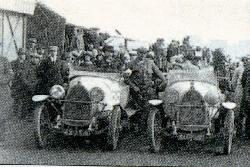 |
| The two Brescia's before the start |
 |
| The Brescia of de Pourtales and de la Rochefoucauld |
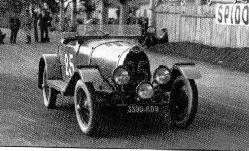 |
| The T40, driven by one of the ladies. |
Of course many asked themselves if the "poor ladies" are capable here, but time showed they were. At the background of the great Duel between Caracciola's Mercedes and five Bentleys officially entered, the little "Bug" followed her way with grace and constancy. Although the record of the Alvis wasn't attained, "class victory" and the best classification of a Molsheim product ever at Le Mans, would convince Ettore that his cars could achieve something here!
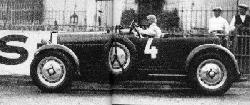 |
| The black T50 of Varzi and Chiron |
The three Bugattis, all painted black, had some excellent drivers also, and the opposition would come only from a Mercedes, one Bentley (private), two Talbots and a Alfa Romeo.
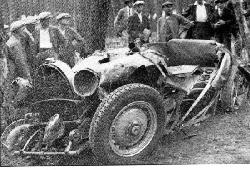 |
| The T50 after Rost's accident |
And all the ill-fate adds up, also to the privately entered Bugs: The T43 breaks it transmission, the ladies Mareuse and Siko, so successful last year, are disqualified in 12th place, at an average of over 100 km/h. The little T37, being in 12th/13th place for a long time, has to retire the beginning of the Sunday afternoon, because of problems with the ignition.
Jean Bugatti, still young and enthusiastic even after last year's mishap, had seen to the preparation of the cars. Apart from the factory entries two small private entries are present, a T37 and a supercharged (!) T40. Opposition comes mainly from the Alfa Romeo 8C's, a Mercedes, an American Stutz and an old Bentley.
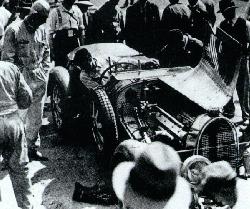 |
| Bouriat in the pits, after his fuel tank has been damaged |
In the early morning the T55 comes back however, at a lap and a half per hour! At twelve, the T55 is only four laps behind the leaders Sommer and Chinetti, who suffer from brake-problems. This seems a possible task! However, the miracle will not take place, Friderich has to stop the car at 12h20, because of the collapse of an oil line. Sommer will win the race.
There is some compensation though, as the T37 of Sebilleau and Delaroche, beaten in their class by a lap and a half by the Aston of Newsome-Windegren, at least beats the other Aston of Bertelli-Briscolli. Never at Le Mans had a Bugatti finished in such a high position (6) and covered so great a distance.
Opposition came from a giant Duesenberg of almost seven litres, and from some 7 Alfa Romeos, of which 5 8C2300, one of which was driven by Sommer, accompanied by a Tazio Nuvolari, new at Le Mans.
Bussienne, in the big T50, takes nicely his place after the untouchable Alfa Romeo's. Never much further than 7th place, the Bugatti, at the middle of the race, is in 5th place. Okay, Sommer and Nuvolari are 14 laps ahead. Mrs. Duprez, beautifully wristed but heavy-footed, keeps her place perfectly, the beauty tamed the beast. However, it is her who, at six in the morning, has to come to the conclusion that her efforts are fruitless. The radiator of the big 8 cylinder has given away, and she has to give up.
The T51A of Czaikowski already had to capitulate long before that, at the height of the duel with the Aston Martins, at the 9th position towards the end of the first day, he had to stop with a broken battery.
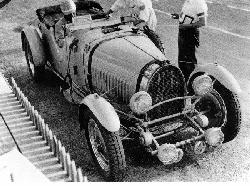 |
| Labric and Veyron's T50 |
This hybrid played no role whatsoever in the race, as did the T55 of Fourny and Decaroli, which was out of the race very soon due to external help. Luckily, the other three cars did draw some attention. The beautiful and powerful T50, painted sky-blue now, did spoil a bit the party of the alfa's. Having started carefully, she was in sixth position at the end of the evening, but would readily go to second position, only four laps behind the later winners Etancelin and Chinetti. However, it wouldn't last. The Sunday had only just begun, when the car came to a standstill at the other and of the circuit.
This loss was even harder when, only a small time afterwards, the T55 of Brunet and André Carré (formerly thought to be Zehender) , superbly driving in 4th place disappeared, also because of an accident.
 |
| The T44 Special |
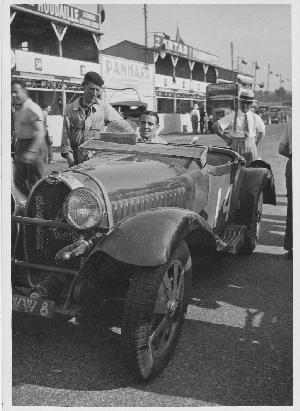
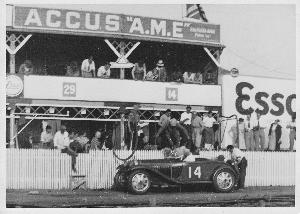
The photographs above are of Carré / Renaldi / Inlander in the 1934 Le Mans Race, photographs © Famille Carré
Bruno Carré comments the following about the 1934 Le Mans race, and the participation in the race of the Type 55, chassis 55028. According to Bruno, it was not Zehender who accompanied Brunet in the Bugatti, but his father: André Carré was a French racing driver who took part in several Grand Prix between 1933 and 1936 e.g. Dieppe 1933 (Charles Farroux wrote an article on what was JR first race and in which he made 6th in La vie automobile) , La baule 1933, Cherbourg 1933/34, Grand Prix de l'Union Motocycliste Française 1934-1935, Grand prix de France Monthlery 1935 etc. in various Bugatti, e.g. a 35c 2L supercharged (à compresseur) bought from Marcel Lehoux.
He raced under the aliases "Jean Renaldi" and later “Inlander” because he did not want his parents to know about him racing, most unfortunately sometimes confused with Goffredo Zehender. He took part with Robert Brunet in the 1934 Le Mans 24h race in the No14, 2.3 L Bugatti T55 supercharged. At 2 am. while in 2nd position Brunet spun the car into the ditch and had to retire. Carré retired from racing in the late 1930’s even though his last race was the Le Mans older pilots rally in 1964 which he won with his co-pilot José Rosinski, himself a well-known pilot in the sixties. Carré was a founder and the treasurer of the Le Mans racing drivers club for many years and his factory premises used to host "Lofty" England and the Jaguar team during their Le Mans visits.
There was one Bugatti left to save the Alsacian honour, the T44 ended in 9th place, only little consolation.
 |
| Villeneuve and Vagniez's T51A, the only Bug out of seven to finish |
Opposition come from a big Duesenberg SJ, driven by Prince Nicolas of Rumania. Two 6 cylinder, 4.5 litre Lagondas, Talbot and Alfas. It rains, but equally Sommer (Alfa) takes the lead at high speed. He has nothing to lose, because, not being with an official team, he just wants to enjoy himself for as long as possible. Behind him the opposition begins
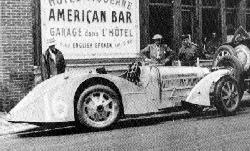 |
| The strange "T35" of the Ecurie Argo |
 |
| The winning car of Wimille and Benoist |
Accompanying the two "tanks" were a T57S of d'Edrez and Leoz, and a T44 of Kippeurt and Poulain. The recent French GP rules, which stated that the Grand Prix should be driven in a sports like car, and not in a real GP car, resulted in the Le Mans race having the same rules as the GP. Apart from eliminating the German and Italian state-financed teams from the French GP (which the Bugatti T57G was to win in 1937), the result of this was a high number of, mainly French, competitors at Le Mans. There were two Talbot's, a Delage Coupe, seven Delahaye and only one Alfa 2.9 litre (Sommer and Guidotti) and the Lagonda of the winners of 1935.
Towards the end of his shift, at 18h30 Jean-Pierre Wimille had already lapped everybody, including his friend Sommer in the Alfa. Robert Benoist also did his best, setting a new lap-record, which Wimille later on would improve, and finally take to 155.2 km/h. Bugatti finally got it right, and takes all records, and for the first time a Win!
Of course there is always a dark side, the other T57G doesn't make it, suffering, again, from a leaking fuel tank (and Araldite still didn't exist!), the T57S has gearbox problems, but Kippeurt in his T44 ends up in an accident involving six cars, and he loses his life.
 |
| The T57C Tank during the race, compare with the 1937 model above |
One car only, against all the others, doesn't seem much. There were six Talbot's. three of them of 4.5 litre, 8 Delahaye's (six 135MS), two Delage 3 litres, a majestic Alfa 2500SS coupe driven by Sommer, and two Super Lagonda V12 4.5 litres, designed by a certain W.O. Bentley.
Entered was a Type 57C, different from the 1937 model, although similar in appearance. This time it was a supercharged car, based on a normal touring frame (not on a T57S chassis.). Although the frame was a classic one, the body, weighing not more than 60 kg, was improved still, together with the Piano-wire wheels of the T59 a very beautiful combination. The brakes are hydraulics and amply ventilated, behind the bonnet there are air extractors, at the sides of the body.
However, in the beginning of the second practice session, the engine breaks down. Wimille, Veyron and Jean Bugatti are thinking about giving up. Not Robert Aumaître though, the chief mechanic. Molsheim is called, and 8 new pistons are brought to Paris, with an Autorail (of Bugatti design, naturally). Here Le Grand Robert is waiting in his T57, to take them to Le Mans. With the help of a local metal worker the block is made ready for the new pistons. On Saturday all is cleaned, the pistons mounted and all is ready for the start!
During a rapid test, the engine doesn't seem to good, the competition is going to take advantage of that. Louis Gerard in his Delage takes the lead, Sommer is out, and Wimille and Veyron follow, not without problems though, the engine overheating. Even the inside wings had been removed, risking disqualification. A wheel breaks, and Wimille goes from 4th place back to sixth! Sunday, at the end of the morning, Gerard is 5 laps ahead of the Bugatti. However, at the beginning of the afternoon all is going to change. The Delage is making more and more bizarre sounds, and has at least two valve springs broken. At 13h00, the Bugatti is two laps ahead! There is another one won! Although Mazaud in a Delahaye has taken almost a second from Wimille's 1937 record.
Jean Bugatti claimed afterwards that the bonnet was never opened during the race, and that a top speed of over 255 km/h was attainable.
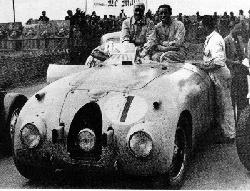 |
| The victorious Wimille and Veyron after the race |
Luckily quite some private racers entered their Bugattis, not being able to do much in the general race, but at least good enough to take some class wins! And of course, the Bugatti record for Le Mans was only improved from year to year. Never a Bugatti arrived at the finish at a lower average than the years before!
Only a few weeks after Wimille and Veyron's win, Jean Bugatti dies after an accident in the same car, the evening of August 11, 1939. Shortly after that the terrors of war put Europe in darkness, the world itself and racing changes. And Bugatti was never to come back again, but will be famous forever, for introducing aerodynamics in racing! It is not until 1994, when we see again one single Bugatti competing against many. A class win had been possible, hadn't it been for that accident almost at the end of the race.
1994 was the year that Le Mans would be made more popular, the specially designed race monsters would be banned, and only "normal" productions cars would be allowed to enter. However Porsche found a way out of these regulations with the "Dauer Porsche", effectively a Porsche 962 purpose built car, converted for road use, and then converted back to race. This was quite some faster than the rest, and would eventually win. Of the real GT class, the Bugatti proved fastest in training, in the GT1 class (engines up to 600HP). In the same class competed MVS Venturis, De Tomaso Panteras, Dodge Vipers, Porsches Carrera RSR (and the famous
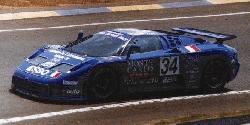 |
| The EB110 during the race |
In this training, a month for the race, the Bugatti was fastest in class, looking and sounding gorgeous, and going quickly, despite the weight penalty of the four-wheel-drive. It was only just faster than the MVS Venturis, and 25 seconds slower than the Dauer Porsches.
For the race itself, I quote
from Autosport:
"Leading the way in the GT class should have been the Bugatti EB110SS, driven by touring car
oldtimer Alain Cudini and French young guns Eric Helary and Jean-Christophe "Jules" Bouillon.
The Italian supercar looked set for a top-six finish despite a very slow start...
One hour before the race, the local Synergic team, which was running the car for publishing magnate Michel Hommell, discovered a fuel leak. The only solution available to mend the car in time for the race was a tube of Araldite.
This allowed the car to do the first couple of shifts with its fuel tank half full. Once
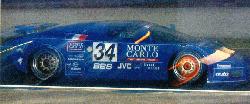 |
| The EB110 in the evening |
classification in class
Type cyl./cc drivers place - km,average (place, cc)
1923 Circuit - 17.2 km
Chenard & Walcker Lagache, Leonard 1st, 2201, 91.8
T13 Brescia 4-1495 M de Pourtales 10th, 1795, 74.8 1st, 1.1-1.5l
S de la Rochefoucauld
T13 Brescia 4-1495 R Marie, L Pichard 22nd, 1415, 59.0 2nd, 1.1-1.5l
1930 Circuit - 16.3 km
Bentley 6 speed Barnato, Kidston 1st, 2921, 121.7
T40 4-1496 Miss M Mareuse 7th, 2165, 90.2 1st, 1.1-1.5l
Miss O Siko
1931 Circuit - 16.3 km
Alfa Romeo 8C2300 Howe, Sir Birkin 1st, 3008, 125.3
T50S 8-4972C A Varzi, L Chiron retired
T50S 8-4972C A Divo, G Bouriat retired
T50S 8-4972C M Rost, C Conelli accident
T43 8-2261C PL Dreyfus, Schuman transmission breakdown
T40 4-1496 Miss M Mareuse disqualified
Miss O Siko
T37 4-1496 S Sebilleau clutch
G Delaroche
1932 Circuit - 13.6 km
Alfa Romeo 8C2300 Sommer, Chinetti 1st, 2944, 122.8
T37 4-1487 S Sebilleau 6th, 2327, 97.0 2nd, 1.1-1.5l
G Delaroche
T55 8-2262C L Chiron, G Bouriat fuel tank
T55 8-2262C S Czaikowski lubrication
E Friderich
T40? 4-1496C C Druck, L Virlouvet accident
1933 Circuit - 13.6 km
Alfa Romeo 8C2300 Sommer, Nuvolari 1st, 3134, 130.6
T50S 8-4972C P Busienne radiator
Miss Duprez
T51A 8-1493C S Czaikowski electric circuit
J Gaupillat
1934 Circuit - 13.6 km
Alfa Romeo 8C2300 Chinetti, Etancelin 1st, 2877, 119.8
T44 8-2992 NJ Mahe, D Desvignes 9th, 2585, 107.7 1st, 2-3l.
T50S 8-4972C R Labric, P Veyron transmission
T55 8-2262C C Brunet, J Carré retired after accident - Pseudo for Carré: Inlander
T55 8-2262C M Fourny, L Decaroli disqualified
T37 special 4-1351 A Bodoignet, F Vallon ?
1935 Circuit - 13.6 km
Lagonda M45R Hindmarsh, Fontes 1st, 2996, 124.9
T51A 8-1493C L Villeneuve 14th, 2633, 109.7 8th, 1.1-1.5l
A Vagniez
T50S 8-4972C R Labric, P Veyron suspension
T57 8-3257 B Souza Dantas gearbox
R Teillac
T44 8-2992 R Kippeurt, E Neubout lubrication
T55 8-2262C B Chaude, M Fourny ignition
T55 8-2262C P Merlin, G d'Arnoux compressor
T35? 8-1991 P Vallee, A Blondeaux engine
1937 Circuit - 13.6 km
T57G 8-3266 JP Wimille, R Benoist 1st, 3288, 137.0 1st, 3-5l.
T57G 8-3266 R Labric, P Veyron fuel tank
T57S 8-3257 R D'Edrez de Sauge gearbox
G Leoz
T44 8-2992 R Kippeurt, R Poulain Mortal accident of Kippeurt
1939 Circuit - 13.6 km
T57C 8-3251C JP Wimille, P Veyron 1st, 3355, 139.8 1st, 3-5l.
1994 Circuit - 13.6 km, with chicanes on Mulsanne straight
Dauer Porsche962LM Dalmas, Haywood 1st, 4671, 194.6
Baldi
EB110SS 12-3498T A Cudini, E Helary accident
JC Bouillon